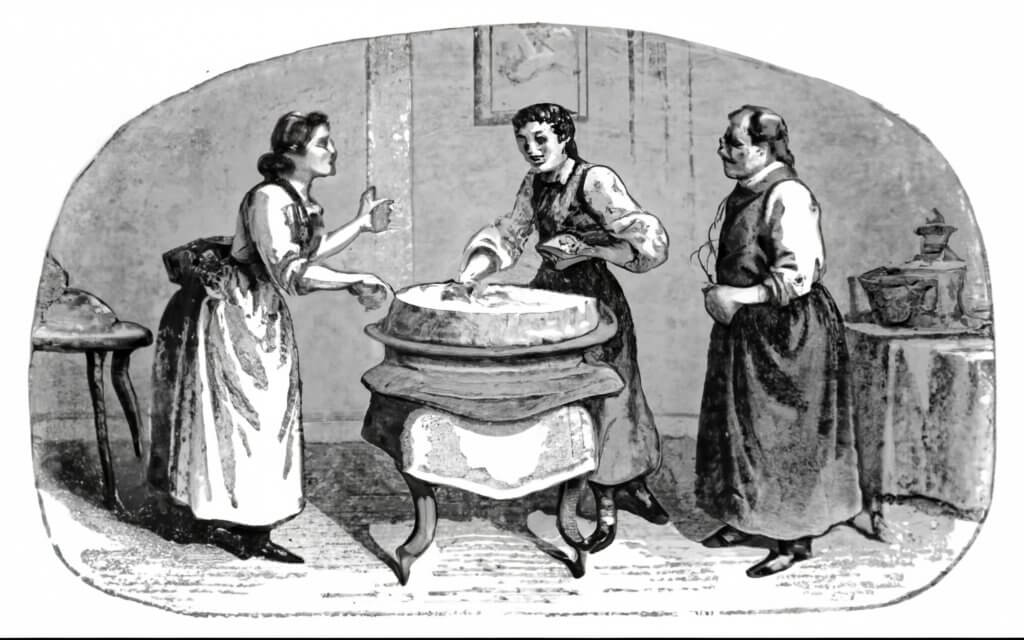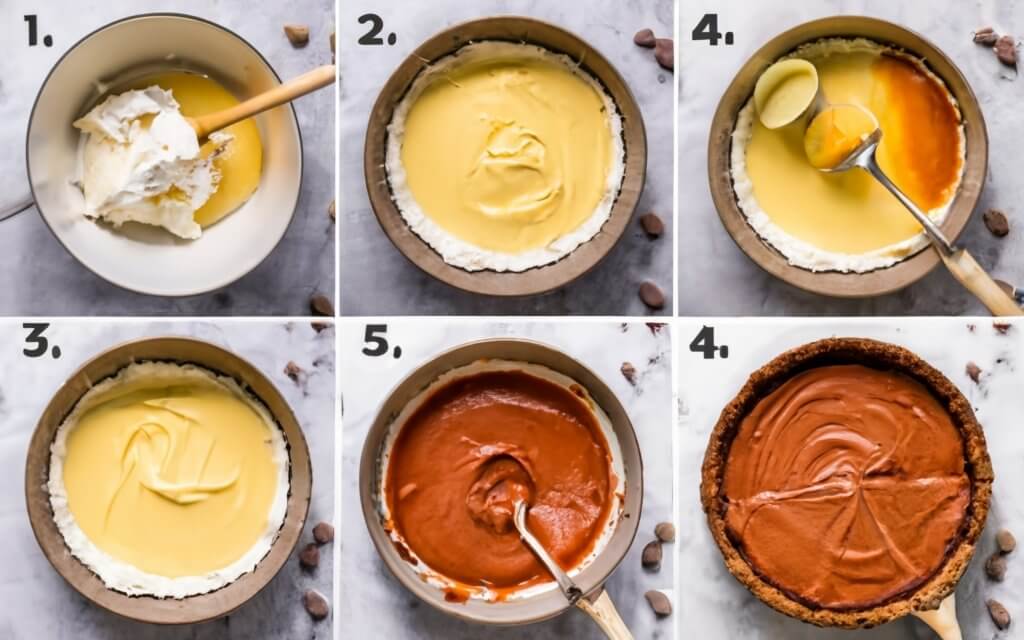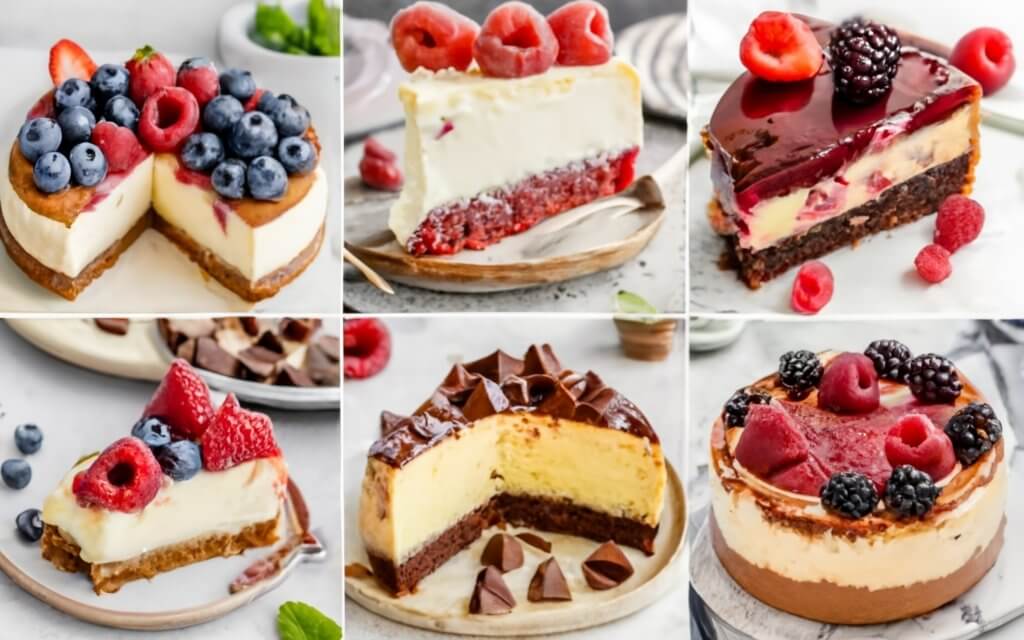Introduction to Philadelphia Cheesecake
The Charm of Philadelphia Cheesecake
Philadelphia cheesecake, a luscious and creamy delight, is more than just a dessert. It’s an experience of rich flavors and velvety textures, and mastering the Philadelphia Cheesecake Recipe is an art in itself. In this guide, we delve into the secrets of creating the perfect cheesecake, exploring essential ingredients, step-by-step instructions, and delightful variations. Whether you’re a seasoned baker or a newcomer to the kitchen, this article promises to guide you through the journey of crafting an exquisite Philadelphia cheesecake.
The Rich History and Cultural Impact of the Philadelphia Cheesecake
The journey of the Philadelphia Cheesecake Recipe began with the simple yet versatile ingredient: cream cheese. Its origins trace back to the early 20th century, evolving from traditional cheesecakes that date even further. This dessert has since become a staple in American households, especially during festive seasons and family gatherings.
The Cream Cheese Revolution
At the heart of every Philadelphia cheesecake is Philadelphia cream cheese, a product that revolutionized cheesecake making. Its smooth, creamy consistency and balanced flavor profile make it the ideal base for this dessert. The cream cheese’s unique texture allows for a cheesecake that’s both dense and light, a paradox that only adds to its allure.
The Cultural Impact
Over the years, Philadelphia cheesecake has not just remained a dessert; it’s become a cultural icon. It’s a dessert that brings people together, a centerpiece at parties, and a comfort food for many. Its versatility in flavors and styles has made it a favorite among chefs and home bakers alike.
In the next sections, we’ll delve into the ingredients that make up this delightful dessert, guiding you through the process of creating your own Philadelphia cheesecake masterpiece. Stay tuned for a journey filled with creamy goodness and sweet surprises!
Crafting the Perfect Cheesecake – Essential Ingredients
Selecting the Best Cream Cheese for Your Cheesecake
The soul of any Philadelphia Cheesecake Recipe is undoubtedly cream cheese. Its rich, creamy texture and subtle tanginess are what give this dessert its signature appeal. For the best results, opt for full-fat Philadelphia cream cheese, as it lends the necessary richness and smoothness.
Learn about selecting the best cream cheese for your cheesecake. For more information on cream cheese and its uses in cheesecakes, see our article on Does Philadelphia Cream Cheese Still Make Cheesecake Filling?
For the best results, opt for full-fat cream cheese, as it lends the necessary richness and smoothness. Discover a variety of cream cheese options suitable for cheesecakes on Allrecipes.
Balancing Sweetness: Sugar and Its Alternatives
Sweetness in a cheesecake is a delicate balance. Granulated sugar is the traditional choice, but don’t shy away from experimenting with alternatives like honey, maple syrup, or even artificial sweeteners for a healthier twist. The key is to maintain the sweetness without overpowering the cream cheese’s flavor.
The Role of Eggs in Cheesecake Consistency
Eggs play a crucial role in cheesecakes. They bind the ingredients together and help in setting the cheesecake as it bakes. Room temperature eggs are ideal as they blend more easily, ensuring a uniform texture.
Choosing the Right Crust for Your Philadelphia Cheesecake
A good crust can elevate your cheesecake to new heights. Graham crackers are a classic choice, offering a sweet and crunchy base. However, feel free to get creative with alternatives like Oreo crumbs, ginger snaps, or even a gluten-free base for those with dietary restrictions.
Incorporating these essential ingredients with care and precision is the first step towards creating a heavenly Philadelphia cheesecake. Each component plays a vital role in the final outcome, so choose wisely and mix gently.
The Philadelphia Cheesecake Recipe – A Step-by-Step Guide
Creating the perfect Philadelphia Cheesecake Recipe is an art, but with these step-by-step instructions, even a novice can master this culinary delight. Let’s dive into the process!
Laying the Foundation: Preparing the Crust
- Crust Basics: Start by finely crushing your choice of biscuits or graham crackers. Mix the crumbs with melted butter to achieve a sandy texture.
- Pressing the Crust: Evenly press the mixture into the bottom of a springform pan. A flat-bottomed cup can help achieve a uniform layer.
- Baking the Base: Pre-bake the crust for about 8-10 minutes at 325°F (163°C). This step ensures a crisp base that holds up to the creamy filling.
Mixing the Perfect Cheesecake Filling
- Cream Cheese Mastery: Begin with room-temperature cream cheese. Beat it until smooth, avoiding overmixing to prevent excess air incorporation.
- Sweet Balance: Gradually add sugar and continue to mix. Remember, the goal is a smooth, lump-free batter.
- Egg-cellent Addition: Add eggs one at a time, mixing just enough to incorporate. Overbeating can cause the cheesecake to rise and fall, leading to cracks.
- Flavor Infusion: Incorporate vanilla extract or other flavorings for an extra layer of taste.
Baking Techniques for a Smooth Cheesecake
- Slow and Steady: Bake the cheesecake in a preheated oven at 325°F (163°C). The key is a gentle bake to avoid surface cracking.
- Water Bath Wonders: For an even more luxurious texture, use a water bath. This method helps cook the cheesecake gently, ensuring a smooth, creamy finish.
- Doneness Test: The cheesecake is done when the edges are set but the center still jiggles slightly. Overbaking can lead to a dry texture.
For an even more luxurious texture, use a water bath. This method helps cook the cheesecake gently, ensuring a smooth, creamy finish. Discover more Expert Cheesecake Baking Tips at Epicurious
Cooling and Setting: The Final Steps
- Patience Pays Off: Let the cheesecake cool gradually in the oven with the door slightly ajar. This slow process prevents sudden temperature changes that can cause cracks.
- Chill Out: Refrigerate the cheesecake for at least 4 hours, preferably overnight. This step is crucial for achieving the perfect set and texture.
Exploring Variations in the Philadelphia Cheesecake Recipe
The beauty of the Philadelphia Cheesecake Recipe lies in its versatility. Let’s explore some delicious variations that can add a twist to the classic recipe.
lassic Baked vs. No-Bake Cheesecake
- Classic Baked Cheesecake: This traditional method involves baking the cheesecake in an oven, resulting in a dense and creamy texture.
- No-Bake Cheesecake: Ideal for those who prefer a lighter texture or lack an oven. This version sets in the fridge and typically includes gelatin or whipped cream for stability.
Flavor Variations
- Fruit Infusions: Top your cheesecake with fresh strawberries, blueberries, or a tangy lemon zest for a refreshing twist.
- Chocolate Lover’s Dream: Incorporate melted chocolate or cocoa powder into the batter for a rich, decadent flavor.
- Exotic Spices: Add a pinch of cinnamon, nutmeg, or pumpkin spice for a warm, aromatic touch.
Dietary Adaptations
- Gluten-Free Options: Use almond flour or crushed gluten-free biscuits for the crust.
- Vegan Varieties: Experiment with vegan cream cheese and agar-agar (a plant-based gelatin alternative) for a dairy-free version.
Each variation offers a unique flavor profile and texture, making Philadelphia cheesecake a dessert that can be tailored to suit any palate or occasion.
Perfecting the Philadelphia Cheesecake Recipe – Common Mistakes and Solutions
Even the most experienced bakers can face challenges when making a Philadelphia Cheesecake Recipe. Here are some common pitfalls and how to avoid them.
Cracked Tops and How to Avoid Them
- Cause: Overbaking or sudden temperature changes.
- Solution: Bake the cheesecake until just set and cool it gradually in the oven with the door slightly open.
Overmixing the Batter
- Cause: Incorporating too much air, leading to a soufflé-like texture and surface cracks.
- Solution: Mix ingredients at a low speed and only until combined. Be particularly gentle after adding eggs.
Baking Temperature Nuances
- Cause: Too high a temperature can cause the cheesecake to rise rapidly and then fall, creating cracks.
- Solution: Use a moderate baking temperature (around 325°F or 163°C) and consider a water bath for even heat distribution.
By understanding and addressing these common issues, you can significantly improve your cheesecake-making skills and ensure a smooth, crack-free dessert.
Serving and Presenting Your Philadelphia Cheesecake Masterpiece
A beautifully presented Philadelphia cheesecake can be the centerpiece of any gathering. Here are some tips to elevate its appearance and serving style.
Creative Topping Ideas for Your Cheesecake
- Fruit Fantasia: Adorn your cheesecake with a vibrant array of fresh fruits like strawberries, raspberries, or kiwi slices for a refreshing contrast.
- Saucy Drizzles: Enhance the cheesecake with rich sauces such as caramel, chocolate, or a berry coulis. A drizzle can add both flavor and visual appeal.
- Whipped Cream Wonders: A dollop of whipped cream adds a light, airy touch. Consider flavored whipped cream for an extra twist.
The Art of Slicing Cheesecake
- The Perfect Slice: Dip a sharp knife in hot water and wipe it dry before each cut. This method ensures clean, precise slices.
- Size Matters: Consider the number of guests and the richness of your cheesecake when deciding on slice size. A smaller, richer cheesecake might warrant thinner slices.
Presentation Tips for an Elegant Dessert
- Plating Perfection: Serve each slice on individual plates with a mint leaf or a dusting of powdered sugar for an elegant touch.
- Theme Matching: Match your serving ware and decorations to the occasion, whether it’s a casual family gathering or a formal dinner party.
With these serving and presentation tips, your Philadelphia cheesecake is sure to impress, both in taste and appearance.
Storing and Preserving the Quality of Your Cheesecake
Proper storage is key to maintaining the quality and flavor of your Philadelphia cheesecake. Here’s how to keep it fresh and delicious.
Best Practices for Refrigerating Cheesecake
- Airtight Storage: Once the cheesecake has cooled completely, cover it with plastic wrap or store it in an airtight container. This prevents it from absorbing other flavors from the fridge.
- Optimal Temperature: Keep your cheesecake in the coldest part of the refrigerator, typically at the back, to ensure it stays firm and fresh.
Freezing Your Cheesecake for Long-Term Storage
- Freeze with Care: Philadelphia cheesecake can be frozen for up to a month. Wrap it tightly in plastic wrap and then aluminum foil before freezing.
- Thawing Process: Thaw the cheesecake overnight in the refrigerator, not at room temperature, to maintain its texture and flavor.
Understanding the Shelf Life of Cheesecake
- Refrigerated Lifespan: A properly stored cheesecake can last up to 5 days in the refrigerator.
- Signs of Spoilage: Look out for any changes in color, texture, or smell. If in doubt, it’s safer to discard the cheesecake.
By following these storage guidelines, you can enjoy your Philadelphia cheesecake for several days, ensuring that none of that creamy goodness goes to waste.
FAQs – Mastering the Philadelphia Cheesecake Recipe
Can I Make Philadelphia Cheesecake Without a Springform Pan?
- Answer: Yes, you can use a regular cake pan or a pie dish, but lining it with parchment paper will make it easier to remove the cheesecake.
How Do I Prevent My Cheesecake from Cracking?
- Answer: Avoid overmixing the batter, bake at a moderate temperature, and cool the cheesecake gradually in the oven with the door slightly open.
Is It Possible to Make a Dairy-Free Philadelphia Cheesecake?
- Answer: Absolutely! Use dairy-free cream cheese alternatives and a plant-based thickener like agar-agar for the filling.
Can I Substitute Sugar with Other Sweeteners?
- Answer: Yes, you can use honey, maple syrup, or artificial sweeteners. However, the texture and flavor might vary slightly.
How Long Should I Chill My Cheesecake Before Serving?
- Answer: Ideally, chill it for at least 4 hours, but overnight is best for the flavors to fully develop and the texture to set properly.
Can I Freeze Philadelphia Cheesecake?
- Answer: Yes, it can be frozen for up to a month. Wrap it tightly in plastic wrap and aluminum foil before freezing.
What Are Some Creative Toppings for Philadelphia Cheesecake?
- Answer: Fresh fruits, flavored whipped creams, chocolate shavings, or nut toppings are great options for adding a creative touch.
Conclusion
In essence, the art of crafting the perfect Philadelphia cheesecake is a delightful blend of precision, creativity, and passion. From selecting the right ingredients to mastering the baking process, each step is a journey towards creating a dessert that’s not just tasty but also a feast for the eyes. Whether you’re a seasoned baker or a curious beginner, the world of cheesecake offers endless possibilities to explore and enjoy. So, gather your ingredients, don your apron, and get ready to whip up a masterpiece that will leave your taste buds dancing with joy!


